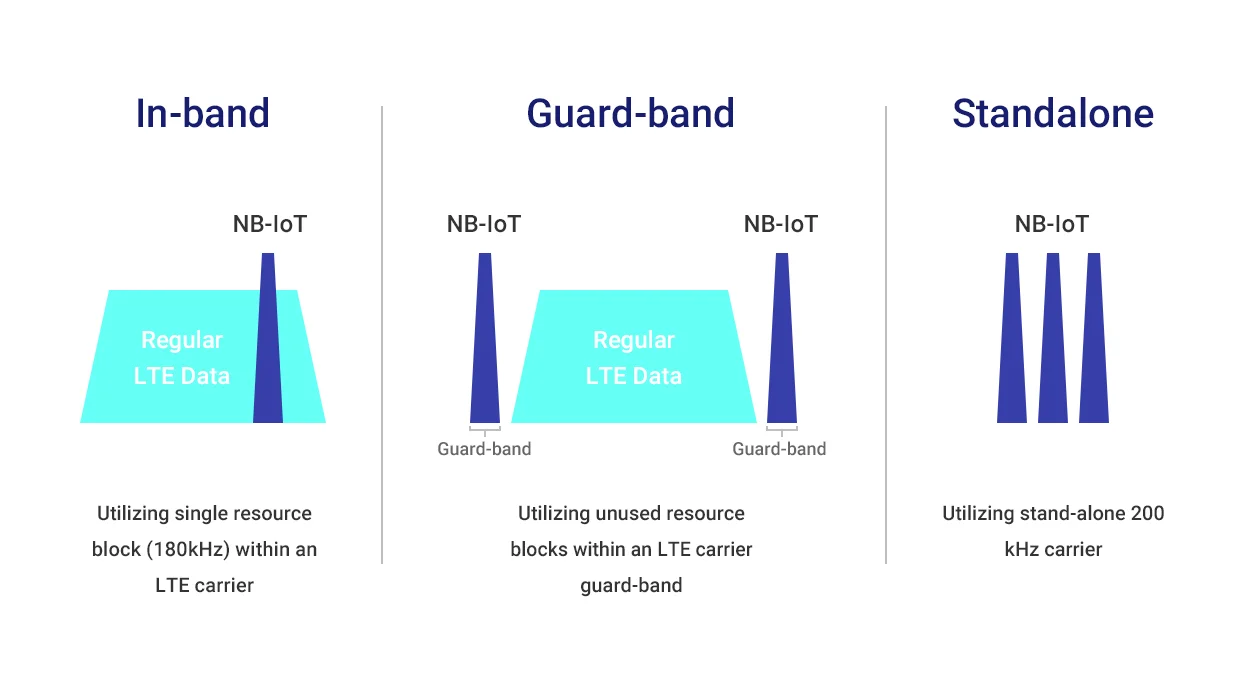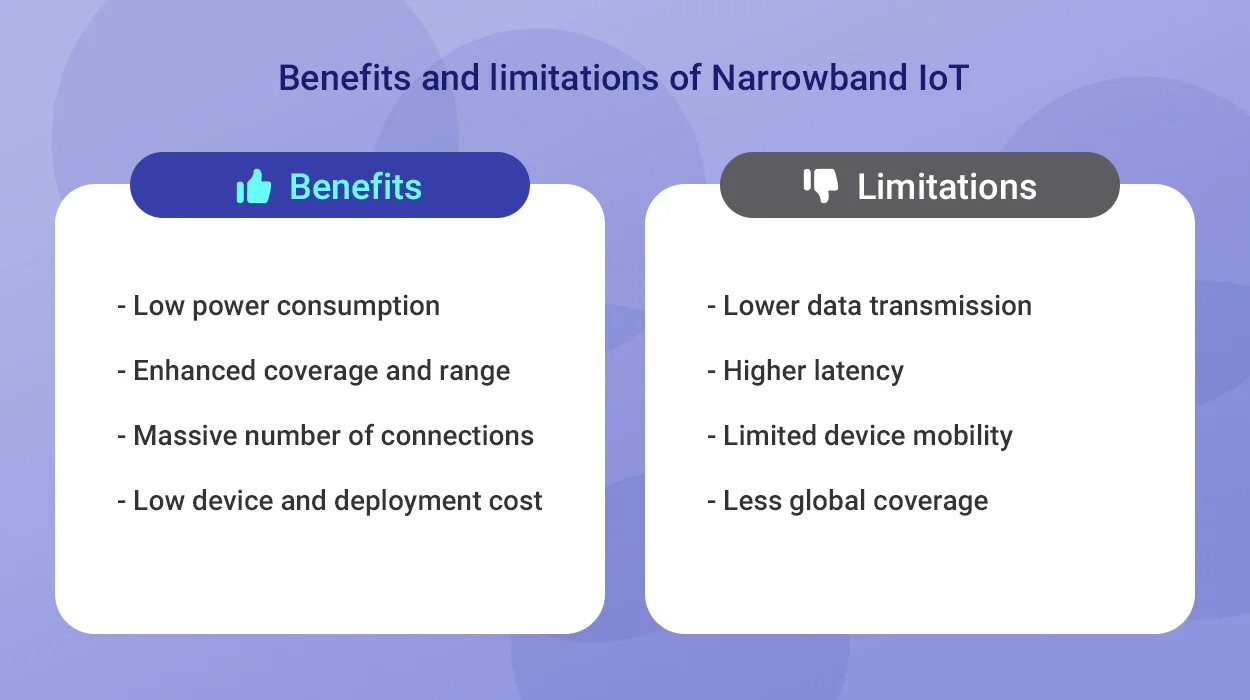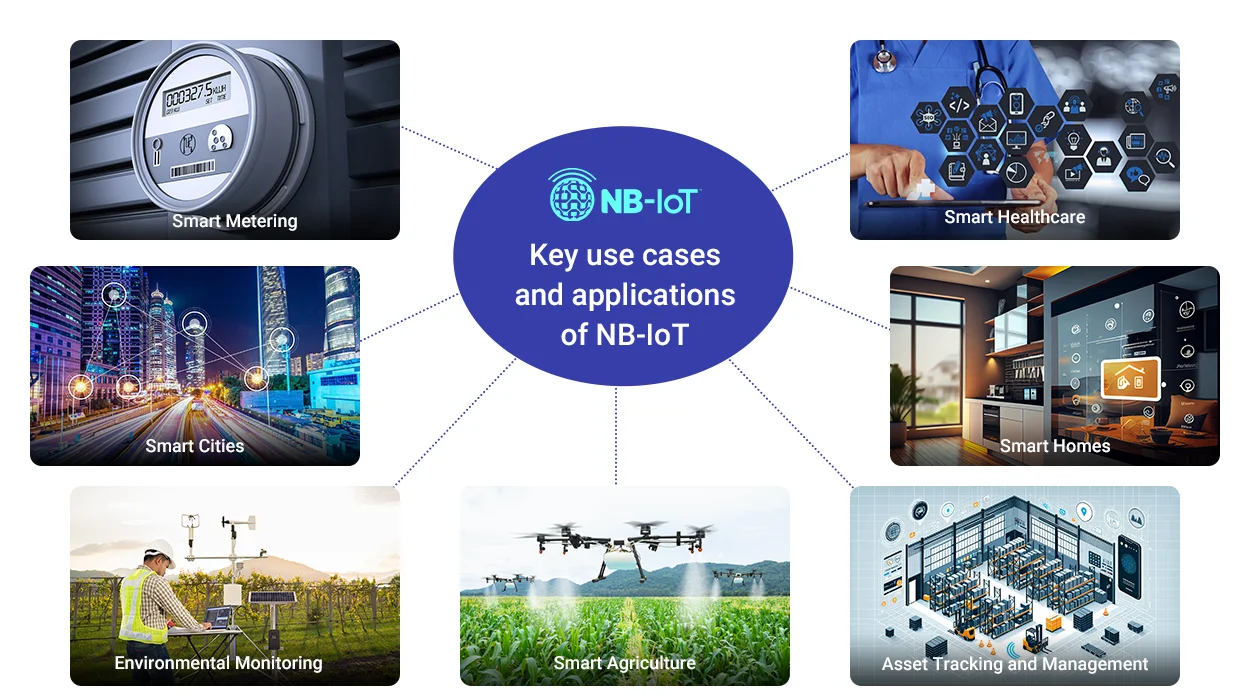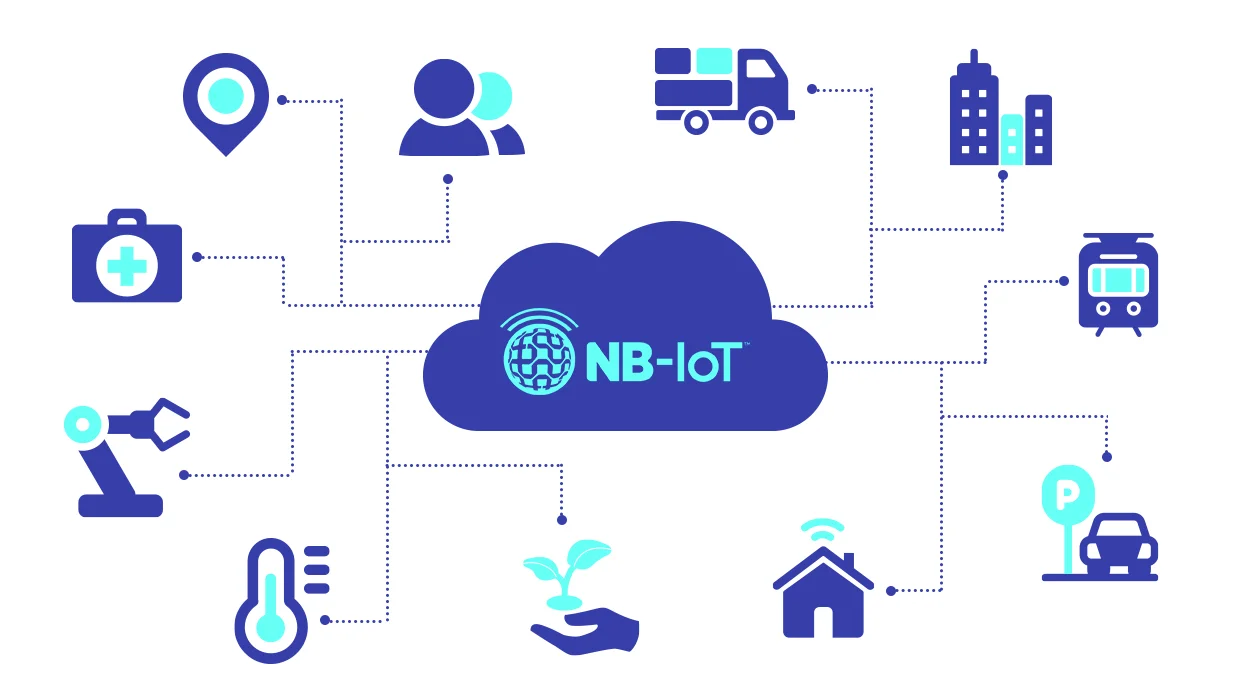From the steam engine to the factory production line, the first waves of the Industrial Revolution fundamentally reshaped human civilization. Today, we stand at the cusp of the next era-defining shift – the rise of the Internet of Things (IoT). However, for the IoT revolution to truly take hold, a dependable connectivity fabric is required – one that can provide extensive, reliable coverage for the anticipated billions of sensors and endpoints. This is where Narrowband IoT (NB-IoT) enters the frame.
So what exactly is NB-IoT, and what unique capabilities does this narrowband cellular standard offer? And how does it relate to existing IoT connectivity options? Let’s dive in.
What is Narrowband IoT?
Narrowband Internet of Things (NB-IoT) is an LPWAN protocol standardized by 3GPP to enable a wide range of new cellular-connected IoT devices and services.
It offers a dedicated wireless pathway optimized for IoT. As the name suggests, Narrowband IoT uses very narrow bandwidth, allowing for excellent extended coverage while maximizing battery life of devices – NB-IoT devices can achieve over 10 years of battery life.
Utilizing licensed spectrum bands such as 4G LTE bands, NB-IoT optimizes them exclusively for IoT connectivity. By refarming existing cellular bands for NB-IoT use rather than requiring new spectrum allocations, this technology can be quickly deployed by mobile network operators.
With excellent coverage extension and extreme energy efficiency, NB-IoT empowers a broad range of new IoT devices to deliver rich data with minimal maintenance cost, overcoming two key barriers to mass adoption of IoT. Fast global deployment is already underway, especially in Asia, Europe and North America.
Narrowband-IoT architecture and how it works
NB-IoT was standardized in 2016 by the 3GPP in Release 13 for operation within licensed spectrum bands owned by mobile carriers. Communication between NB-IoT devices and the network occurs within a designated narrow band of 200kHz, compared to much wider bands used by standard cellular connectivity.
The NB-IoT architecture consists of end devices (sensors), base stations or access points, the core network and application servers/platforms. Optional components like gateways may be utilized to connect nodes inside buildings or underground when direct access is not possible.
NB-IoT has three distinct deployment modes to maximize coverage across various infrastructure:
- In-band – Utilizes resource blocks within a normal LTE carrier
- Guard band – Utilizes unused resource blocks within a normal LTE carrier
- Standalone – Utilizes stand-alone carrier in dedicated spectrum

By leveraging existing cellular infrastructure and spectrum, NB-IoT provides an efficient IoT solution supported by major hardware and chipset vendors globally. It can co-exist with other cellular technologies like 2G, 3G, 4G, LTE-M and 5G through its flexible deployment models.
What are the benefits and limitations of NB-IoT
Narrowband IoT brings immense connectivity capabilities but also comes with some technical constraints. Understanding both the advantages and current downsides allows properly setting expectations and making an informed decision about when NB-IoT is the best fit for an application.

Benefits of Narrowband IoT
- Low power consumption– Ultra low power is achieved via small transmission bandwidth and power saving features of inactive transmission periods like PSM and eDRX. This supports longer years of battery life, essential for remote devices with limited power access.
- Enhanced coverage and range– Using a narrowband signal and packet retransmissions, NB-IoT achieves reliable connectivity indoors and underground. Its range reaches ~1km urban, ~10km rural – ideal for remote devices.
- Massive number of connections– An NB-IoT base station can support over 50,000 devices simultaneously by efficient scheduling of transmission and sleep windows. This scalability supports massive deployments – vital for large-scale IoT networks across infrastructure.
- Low device and deployment cost– By minimizing device complexity to just essential connectivity, NB-IoT hardware costs a fraction of 4G/5G modems. Small data plans also cost less. With no gateway required and leveraging existing bands, deployments are far cheaper than building dedicated LPWAN networks.
Limitations of Narrowband IoT
- Lower data transmission– NB-IoT has lower bandwidth and speed than LTE-M, lacking capability for high data transfers. It cannot support voice/video applications demanding large throughput.
- Higher latency– Compare to 4G and 5G, NB-IoT experiences more lag between data packets being transmitted and received. It is not optimal for use cases needing real-time, low latency communication.
- Limited device mobility– With low bandwidth and slow uplink/downlink rates, NB-IoT is best for fixed or very low mobility devices. Fast handovers between network cells like 4G-LTE and 5G are not supported efficiently.
- Less global coverage– NB-IoT deployment is still ramping up in many regions globally. Fewer roaming agreements for NB-IoT networks than mobile limit seamless worldwide coverage currently.
Is NB-IoT secure or can it be hacked
NB-IoT utilizes the proven security framework defined by 3GPP for LTE networks. This includes mutual authentication between the device and network, over-the-air encryption of data via session keys, and signed firmware updates. Additional device-level strategies like tamper proofing and anomaly detection further harden security.
Another benefit from 3GPP standards-compliance is that NB-IoT supports both current security protocols used across cellular networks as well as any new features added in the future.
While no technology is completely immune from tampering or hacking, NB-IoT offers robust standardized security measures on par with current mobile networks to protect against a range of cyber threats that extends right down to the IoT edge devices.
Key use cases and applications of NB-IoT
With its long battery life, expansive range, small data packet transfers, and strong security – NB-IoT is an ideal technology for connecting sensors, monitors, and actuators across infrastructure systems to enable:

Smart Metering
Real-time remote reading of gas, electric and water usage without need for manual checks. Insights enable better energy conservation and leak detection. NB-IoT’s low power and enhanced range suit even challenging locations.
Smart Cities
Environmental sensors for air/water quality, sound monitoring, waste bin overflow, parking space tracking, infrastructure monitoring, and smart lighting that adjusts based on ambient conditions and people flow.
Environmental Monitoring
Farm fields, rivers, wilderness, and protected conservation areas can be monitored for conditions, equipment operations, intrusions etc. without extensive power or communication infrastructure.
Smart Agriculture
Inexpensive moisture sensors, equipment monitors, soil nutrient testers connected via NB-IoT deliver better visibility to optimize watering, fertilizers, and track crops.
Asset Tracking and Management
Affordable battery-powered NB-IoT tags monitor location and condition of vehicles, heavy machinery, returnable transport items (pallets, containers), and remote asset infrastructure.
Smart Homes
Sensors monitor room occupancy, temperature, humidity, noise, light levels while controllers adjust HVAC, lighting, and appliances automatically based on conditions and usage patterns to improve comfort, safety and energy efficiency.
Smart Healthcare
The low power needs and wide area connectivity of NB-IoT are ideal for improving patient care through remote monitoring during treatment. A fall-down location system based on NB-IoT allows early notification if at-risk patients attempt to stand or move on their own. Care staff can be alerted to assist the patient promptly.
The applications extend into nearly every industry from transportation, to energy, education, retail, among others. Almost anything that needs long term connectivity for low bandwidth data transmissions is a potential fit for NB-IoT.
Comparisons between NB-IoT and other LPWANs
While other power-efficient IoT networking options exist, NB-IoT combines strengths that make it the leading contender for a wide variety of deployments. Here we compare NB-IoT against three other widely used Low Power Wide Area Networking technologies – LTE-M, Sigfox and LoRaWAN:
NB-IoT vs LTE-M
NB-IoT and LTE-M are both cellular LPWAN technologies standardized by 3GPP for IoT. However, LTE-M supports higher bandwidth at 1.4MHz with faster peak data rates up to 1Mbps. LTE-M also enables full mobility and voice support unlike NB-IoT. But the tradeoff is that LTE-M consumes more power despite optimizations like PSM and eDRX.
Overall, LTE-M fits latency-sensitive applications needing higher bandwidth, while NB-IoT is ideal for static or slow moving devices sending tiny amounts of non-time-critical data. LTE-M requires paying royalties to patent holders, but NB-IoT avoids gateway costs by leveraging existing cellular spectrum. The standards are complementary for different IoT use cases – LTE-M for robust communication and NB-IoT for ultra power conservation.
NB-IoT vs LoRa
The key differences are that NB-IoT operates in licensed cellular spectrum like 4G LTE, while LoRa uses unlicensed spectrum in the ISM bands. This means NB-IoT benefits from the security and reliability of cellular networks, while LoRa offers more flexibility since anyone can deploy their own LoRa network.
NB-IoT also has lower latency and higher throughput than LoRa. However, LoRa has a longer range, lower power consumption, and lower module costs. LoRaWAN prioritizes minimizing power consumption, achieving up to 15+ years of battery life.
NB-IoT vs Sigfox
Sigfox is another competing LPWAN technology that uses unlicensed spectrum in the ISM radio bands. It uses ultra narrow band modulation to provide long range communications while using very little power.
A key difference between NB-IoT and Sigfox is that NB-IoT has greater bandwidth, higher data rates, and lower latency compared to Sigfox. NB-IoT can offer throughput up to 250 kbps with latency of less than 10s. Sigfox has maximum throughput of 100bps and a typical latency of 1-30s. Data transfer also has no return channel back to devices.
However, Sigfox has some advantages in terms of simplicity and global coverage. Sigfox networks are easier to deploy and have already achieved broad coverage globally. NB-IoT coverage depends on cellular LTE buildouts so may be more limited.
| NB-IoT | LTE-M | LoRa | Sigfox | |
| Standardization | 3GPP | 3GPP | LoRa Alliance | ETSI |
| Bandwidth | 200 KHz | 1.4 MHz | 250 KHz | 100 Hz |
| Frequency | Licensed | Licensed | Unlicensed | Unlicensed |
| Data Throughput | < 250kbps | < 1Mbps | < 10kbps | < 100bps |
| Latency | Medium | Low | Medium | Medium |
| Mobility Management | ❌ | ✔ | ✔ | ✔ |
| Extended Coverage | ✔ | ✔ | ✔ | ✔ |
| Power Consumption | Medium Low (Higher than LoRa) | Medium (Higher than NB-IoT) | Very Low | Low |
| Private Networks Possible | No | No | Yes | No |
| Module Cost | $7-12 | $10-15 | $9-12 | $5-10 |
| Radio Cost | $ | $$$ | $ | $ |
FAQs about NB-IoT
Is there a fee for using Narrowband-IoT?
Yes – data plans are purchased from mobile carriers similar to smartphones. However, given the tiny packet sizes, costs can be well under $1 per device monthly. Fees vary among operators based on factors like device count and data usage.
Is NB-IoT focused on energy efficiency?
Absolutely – 10+ year battery life is achievable allowing for entirely battery operated endpoints. Combined with enhanced coverage, this enables applications not previously possible.
What is the latency rate of Narrowband IoT transmissions?
Most data transfers complete within 1-10 seconds. For delay sensitive needs under 1 second, LTE-M is likely the better fit.
























